DOGS
Behavioral Problems
Think of it this way -- you've just been placed in a foreign land -- you don't speak the language, you don't understand what's expected and a lot of new -- sometimes frightening, sometimes exciting -- experiences are ahead of you. That's a taste of what it might feel like to a dog -- be it puppy or adult -- that has just come to your house to stay, hopefully for life.
There are bound to be a few problems along the way. The thing to remember is that most problem behaviors can be rectified with patience and love. The first step is usually trying to see the world as your dog and then together you both can start to speak the same language.
Corbis
Dogs, like humans, can develop irrational fears or phobias. Dogs seem particularly vulnerable to developing anxiety when separated from their owners. Separation anxiety is expressed differently in different dogs.
Signs that your dog may suffer from separation anxiety:
- Dogs become extremely distressed when family members leave them alone.
- Dogs may injure themselves in frantic attempts to get out (jump through plate glass windows, dig through doors with their claws, break their teeth, rip their paws trying to get out of the crate).
- Bark continuously when owners are away.
- Become destructive and do considerable damage (scratching and chewing).
- Lose their house training and eliminate in the house.
What to do?
Recent research has explored the use of human anti-anxiety medications for use with canine anxiety problems. These have been shown to have some effectiveness, but usually the best results are achieved with behavioral interventions supplemented by medication when the problem is severe. Consult your veterinarian if the problem is severe.
PhotoDisc/Getty Images
Canine aggression is a serious problem.
What to do?
- Seek help from your vet to eliminate the possibility of physical causes.
- Consult an animal behaviorist or a trainer to assess the situation.
- Develop a plan to modify human-dog interaction.
- The best way to treat aggression is prevention: Unless you are an experienced dog owner, don't choose an aggressive breed and avoid play biting.
- Socialize your dog well.
- Don't allow your puppy to growl and snap because it's cute; discourage that from the start.
Corbis
A bored, anxious dog seeks an outlet for his energy and a release for his stress. When combined with a lack of exercise, this is a prescription for an unwanted remodeling of your house. If your dog does any damage in your presence, correct him and distract him into acceptable activities. Until he understands his boundaries, keep him either supervised or connected to you by leash.
If the damage occurs in your absence try some of the following:
- Crate your dog (unless the problem may be due to separation anxiety).
- Restrict him to a truly dog-proofed area.
- Try leaving a radio on.
- Hide toys for him to find.
- Hire a dog-walking service to break up his day.
- Provide your dog with stimulating and appropriate chew toys.
If destructive behavior continues, consult an animal behaviorist or trainer for advice.
Dick Selby/Idaho Press Tribune/Associated Press |
All dogs bark, but as with digging, some breeds bark, howl and generally vocalize more than others. Keep this in mind when choosing your pet.
- If your dog barks excessively, try immediate correction and diversion to another activity. However, if your dog perceives a human's verbal reprimand as welcome attention or even a "bark-a-long," he may decide to bark more. Try teaching a "speak" command.
- Once this is learned, teach "quiet."
- Divert your dog's attention by taking him to another room, and after a few seconds of quiet, reward him for his silence.
What do you do if you aren't home to hear the barking -- but your neighbors are?
Unfortunately, a lot of problem barking occurs when you aren't there to hear it, but your neighbors are. Separation anxiety is often the cause of such barking. If your dog is outside during the day:
- Block his view of the neighbors' properties so that visual cues will not start him barking (of course, sounds from a neighboring yard may still set him off).
- Try a bark-activated collar that delivers a whiff of citronella (generally unpleasant to dogs) when the dog barks.
If barking becomes a real neighborhood nuisance, and even professionals can't help, you may have to choose between giving up your dog or having him debarked, a surgical alteration of the vocal cords to reduce the volume of sound. De-barking is controversial because many people consider it inhumane. It should be considered only when the other alternative is euthanasia.
PhotoDisc/Getty Images |
Dogs often jump up on people simply as an enthusiastic greeting. Avoid talking enthusiastically or waving your arms when entering a room; this just encourages the dog's behavior. Instead, immediately command the dog to sit, and then reward this behavior.
Unruly dogs jump up on owners and generally do as they please. Try to avoid having to constantly use the negative commands "off!" or "no!" Instead:
- When the dog jumps up, move back and say, "Sit."
- When he complies with your command, crouch down and reward his quiet behavior by calmly stroking his sides.
- Don't neglect the reward and praise once he is sitting consistently at your arrival or you may inadvertently encourage the dog to return to jumping for the increased attention. The idea is to get him to realize that by sitting he will get attention.
- If your dog ignores your commands, keep him on the leash at all times outdoors and revisit the basics of "sit" and "heel" until he is under control. Letting him run loose only exacerbates the problem.
EyeWire/Getty Images |
Dogs like to chase fast-moving objects such as cars, bicycles or other animals, and often get killed doing so.
- Confine your dog in such a way that he cannot chase cars.
- When on a walk, get your dog to heel or place him in a sit-stay to prevent chasing behavior, and praise him enthusiastically for his obedience.
- If he ignores your commands and takes off after a car, an in-line skater or a neighbor's cat, intervene immediately with, "No!" and tug on the leash sharp enough to make him fall back.
- Next, work on some remedial basic training to prevent this dangerous behavior from recurring.
Corbis
- Correct your dog if he starts digging in inappropriate areas, but since digging is an instinctive activity, provide him with a fenced-in, free-dig zone of his own, and teach him the "dig" command.
- In your absence, limit his access to other areas of the yard. Provide other outlets for his physical energy.
PhotoDisc/Getty Images |
The dog's habit of eating his own or other animals' stools, called coprophagia, is particularly disgusting to people. Your dog, however, sees no problem with eating excrement, and herbivore feces may even provide nutrients. However, various internal parasites also may be ingested in this way. While numerous theories have been advanced to explain coprophagia, treatment is the same.
- Confirm with your vet that your dog's diet is adequate.
- Ask your vet for an additive for your dog's food to make his stools distasteful.
- Clean up immediately after your dog defecates.
- Place cat litter boxes out of reach to remove temptation.
- If your dog tries to eat feces while on a walk, correct with, "No!" or "Out!"
PhotoDisc/Getty Images |
To some dogs, a fence is just a brief obstacle on the way to adventures in the neighborhood.
- Sterilizing dogs will make them less interested in roaming.
- Since an open gate is the usual escape route, be sure everybody knows that it must be shut securely.
- If your dog is tempted by visual cues, try to block his view with landscaping or solid fencing.
- Making sure your dog is well-exercised and has amusing toys will also help keep him in the yard.
- If you have a persistent climber or digger, consider stringing electric pet fencing along the top or bottom of your fence to deter him.
PhotoDisc/Getty Images |
While this practice offends human sensibilities, a dog's perspective is different. He is exploring and enjoying new tastes and smells. However, beyond the mess that the dog can make, garbage may contain dangerous chemicals, bacteria-laden food and sharp objects that can cause serious harm. Deterrence works best.
- Securely latch garbage cans and remove them from the dog's area.
- If you catch your dog in the act, say, "No," and reward his compliance with praise -- not food.
- A head halter can be a great help when walking your dog in areas where litter or refuse is present. With good reflexes, you can usually steer the dog's head away before he picks up a piece of garbage.
- If your dog is faster than you are, say, "No!" or "Out!"
PhotoDisc/Getty Images |
Your dog will naturally be interested in human food. It tastes and smells good, and besides, his humans are eating it. But that cute, begging puppy very quickly becomes a nuisance as his size and appetite increase.
The only way to stop begging is to never reward your dog with that one little snack because he looks so adorable.
Occasionally giving your dog a taste from your plate provides strong reinforcement for a behavior you want to stamp out. So when your dog begs, put him in a "down" or "sit-stay" position some distance from the table.
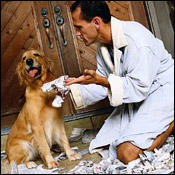
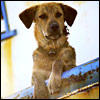
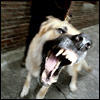
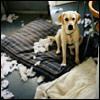

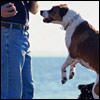
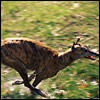
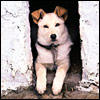
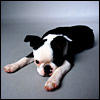
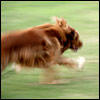
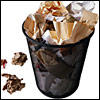
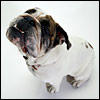
No comments:
Post a Comment